Compact Dual-Circularly Polarized Traveling-Wave Series-Fed Patch Array for Use as a Non-Linear Tag Antenna for Bio-Sensing Applications
Abstract
:1. Introduction
2. Proposed Antenna Design
2.1. Design and Configuration of Antenna
2.2. Trade-Off between Total Efficiency and Axial Ratio Depending on Chord Length
3. Results and Discussion
3.1. Experiment Result
3.2. Comparative Analysis
3.3. Performance Prediction of a Notional Sensing System
4. Conclusions
Author Contributions
Funding
Institutional Review Board Statement
Informed Consent Statement
Data Availability Statement
Conflicts of Interest
References
- Lin, J.C.; Kiernicki, J.; Kiernicki, M.; Wollschlaeger, P.B. Microwave Apexcardiography. IEEE Trans. Microw. Theory Tech. 1979, 27, 618–620. [Google Scholar] [CrossRef]
- Lin, J.C. Noninvasive microwave measurement of respiration. Proc. IEEE 1975, 63, 1530. [Google Scholar] [CrossRef]
- Droitcour, A.; Lubecke, V.; Lin, J.; Boric-Lubecke, O. A microwave radio for Doppler radar sensing of vital signs. In Proceedings of the IEEE MTT-S International Microwave Symposium Digest, Phoenix, AZ, USA, 20–24 May 2001; Volume 1, pp. 175–178. [Google Scholar] [CrossRef]
- Droitcour, A.D.; Boric-Lubecke, O.; Lubecke, V.M.; Lin, J.; Kovacs, G.T.A. Range correlation and I/Q performance benefits in single-chip silicon Doppler radars for noncontact cardiopulmonary monitoring. IEEE Trans. Microw. Theory Tech. 2004, 52, 838–848. [Google Scholar] [CrossRef]
- Kim, B.; Jin, Y.; Choi, Y.; Lee, J.; Kim, S. Low-Complexity Super-Resolution Detection for Range-Vital Doppler Estimation FMCW Radar. J. Electromagn. Eng. Sci. 2021, 21, 236–245. [Google Scholar] [CrossRef]
- Peng, K.-C.; Sung, M.-C.; Wang, F.-K.; Horng, T.-S. Noncontact Vital Sign Sensing Under Nonperiodic Body Movement Using a Novel Frequency-Locked-Loop Radar. IEEE Trans. Microw. Theory Tech. 2021, 69, 4762–4773. [Google Scholar] [CrossRef]
- Nourshamsi, N.; Vakalis, S.; Nanzer, J.A. Joint Detection of Human and Object Motion Using Harmonic Micro-Doppler Radar and Harmonic Tags. IEEE Antennas Wirel. Propag. Lett. 2020, 19, 930–934. [Google Scholar] [CrossRef]
- Zhu, L.; Hà, T.D.; Chen, Y.-H.; Huang, H.; Chen, P.-Y. A Passive Smart Face Mask for Wireless Cough Monitoring: A Harmonic Detection Scheme with Clutter Rejection. IEEE Trans. Biomed. Circuits Syst. 2022, 16, 129–137. [Google Scholar] [CrossRef]
- Mishra, A.; McDonnell, W.; Wang, J.; Rodriguez, D.; Li, C. Intermodulation-Based Nonlinear Smart Health Sensing of Human Vital Signs and Location. IEEE Access 2019, 7, 158284–158295. [Google Scholar] [CrossRef]
- Viikari, V.; Seppa, H. RFID MEMS Sensor Concept Based on Intermodulation Distortion. IEEE Sens. J. 2009, 9, 1918–1923. [Google Scholar] [CrossRef]
- Mishra, A.; Wang, J.; Rodriguez, D.; Li, C. Utilizing Passive Intermodulation Response of Frequency-Modulated Continuous-Wave Signal for Target Identification and Mapping. IEEE Sens. J. 2021, 21, 17817–17826. [Google Scholar] [CrossRef]
- Mishra, A.; Li, C. A Low Power 5.8-GHz ISM-Band Intermodulation Radar System for Target Motion Discrimination. IEEE Sens. J. 2019, 19, 9206–9214. [Google Scholar] [CrossRef]
- ANALOGDEVICES Product HMC-XTB110 Data Sheet. Available online: https://www.analog.com/en/products/hmc-xtb110.html#product-overview (accessed on 15 May 2023).
- Tahir, N.; Brooker, G. Toward the Development of Millimeter Wave Harmonic Sensors for Tracking Small Insects. IEEE Sens. J. 2015, 15, 5669–5676. [Google Scholar] [CrossRef]
- Lee, J.H.; Hwang, J.M.; Choi, D.H.; Park, S.O. Noninvasive Biosignal Detection Radar System Using Circular Polarization. IEEE Trans. Inf. Technol. Biomed. 2009, 13, 400–404. [Google Scholar] [CrossRef]
- Jiang, Z.H.; Gregory, M.D.; Werner, D.H. Design and Experimental Investigation of a Compact Circularly Polarized Integrated Filtering Antenna for Wearable Biotelemetric Devices. IEEE Trans. Biomed. Circuits Syst. 2016, 10, 328–338. [Google Scholar] [CrossRef]
- Bhattacharjee, S.; Maity, S.; Chaudhuri, S.R.B.; Mitra, M. A Compact Dual-Band Dual-Polarized Omnidirectional Antenna for On-Body Applications. IEEE Trans. Antennas Propag. 2019, 67, 5044–5053. [Google Scholar] [CrossRef]
- Yang, Z.J.; Xiao, S.Q.; Zhu, L.; Wang, B.Z.; Tu, H.L. A Circularly Polarized Implantable Antenna for 2.4-GHz ISM Band Biomedical Applications. IEEE Antennas Wirel. Propag. Lett. 2017, 16, 2554–2557. [Google Scholar] [CrossRef]
- Oh, S.; Park, H.S.; Oh, J.; Hong, S.K. Circularly Polarized S/C Dual-Band Antenna for Nonlinear Detection. IEEE Antennas Wirel. Propag. Lett. 2022, 21, 1467–1471. [Google Scholar] [CrossRef]
- Liu, B.; Sha, K.; Jia, Y.Q.; Huang, Y.H.; Hu, C.C.; Li, L.; Wang, D.W.; Zhou, D.; Song, K.X. High quality factor cold sintered LiF ceramics for microstrip patch antenna applications. J. Eur. Ceram. Soc. 2021, 41, 4835–4840. [Google Scholar] [CrossRef]
- Liu, B.; Sha, K.; Zhou, M.F.; Song, K.X.; Huang, Y.H.; Hu, C.C. Novel low-εr MGa2O4 (M = Ca, Sr) microwave dielectric ceramics for 5 G antenna applications at the Sub-6 GHz band. J. Eur. Ceram. Soc. 2021, 41, 5170–5175. [Google Scholar] [CrossRef]
- Din, I.U.; Ullah, W.; Abbasi, N.A.; Ullah, S.; Shihzad, W.; Khan, B.; Jayakody, D.N.K. A Novel Compact Ultra-Wideband Frequency-Selective Surface-Based Antenna for Gain Enhancement Applications. J. Electromagn. Eng. Sci. 2023, 23, 188–201. [Google Scholar] [CrossRef]
- Vincenti Gatti, R.; Rossi, R.; Dionigi, M. Single-Layer Line-Fed Broadband Microstrip Patch Antenna on Thin Substrates. Electronics 2021, 10, 37. [Google Scholar] [CrossRef]
- Raptis, V.; Tatsis, G.; Votis, C.; Chronopoulos, S.K.; Christofilakis, V.; Kostarakis, P. Tuning Techniques for Planar Antennas in Wireless Communication. In Proceedings of the AIP Conference 7th International Conference of the Balkan Physical Union, Alexandroupolis, Greece, 9–13 September 2009; pp. 1053–1057. [Google Scholar] [CrossRef]
- Raptis, V.; Tatsis, G.; Votis, C.; Chronopoulos, S.K.; Christofilakis, V.; Kostarakis, P. Active Tuning Antennas for Wireless Communication. In Proceedings of the AIP Conference 7th International Conference of the Balkan Physical Union, Alexandroupolis, Greece, 9–13 September 2009; pp. 1058–1062. [Google Scholar] [CrossRef]
- Chen, S.J.; Fumeaux, C.; Monnai, Y.; Withayachumnankul, W. Dual Circularly Polarized Series-Fed Microstrip Patch Array with Coplanar Proximity Coupling. IEEE Antennas Wirel. Propag. Lett. 2017, 16, 1500–1503. [Google Scholar] [CrossRef]
- Yang, Y.H.; Guo, J.L.; Sun, B.H.; Cai, Y.M.; Zhou, G.N. The Design of Dual Circularly Polarized Series-Fed Arrays. IEEE Trans. Antennas Propag. 2019, 67, 574–579. [Google Scholar] [CrossRef]
- Yasin, T.; Baktur, R. Bandwidth Enhancement of Meshed Patch Antennas Through Proximity Coupling. IEEE Antennas Wirel. Propag. Lett. 2017, 16, 2501–2504. [Google Scholar] [CrossRef]
- Chen, S.J.; Withayachumnankul, W.; Monnai, Y.; Fumeaux, C. Linear Series-Fed Patch Array with Dual Circular Polarization or Arbitrary Linear Polarization. In Proceedings of the International Conference on Electromagnetics in Advanced Applications (ICEAA), Granada, Spain, 9–13 September 2019; pp. 0365–0369. [Google Scholar] [CrossRef]
- Lee, J.E.; Lee, J.M.; Hwang, K.G.; Seo, D.W.; Shin, D.S.; Lee, C.H. Capacitively Coupled Microstrip Comb-Line Array. Antennas for Millimeter-Wave Applications. IEEE Antennas Wirel. Propag. Lett. 2020, 19, 1336–13394. [Google Scholar] [CrossRef]
- Balanis, C. Antenna Theory: Analysis and Design; John and Wiley and Sons: Hoboken, NJ, USA, 2005; pp. 815–823. [Google Scholar]
- Kortright, M.A.B.; Simons, R.N. K-Band Cross-Aperture Coupled Circularly Polarized Dual Frequency Microstrip Patch Antenna with Single Feed. In Proceeding of the IEEE International Symposium on Antennas and Propagation & USNC/URSI National Radio Science Meeting, Boston, MA, USA, 8–13 July 2018; pp. 337–338. [Google Scholar] [CrossRef]
- Kortright, M.A.B.; Simons, R.N. Feasibility Study of K-band E-Shaped Circularly Polarized Microstrip Patch Antenna Elements for SATCOM Receive Arrays. In Proceeding of IEEE International Symposium on Antennas and Propagation & USNC/URSI National Radio Science Meeting, Boston, MA, USA, 8–13 July 2018; pp. 345–346. [Google Scholar] [CrossRef]
- Luo, Q.; Gao, S.; Zhang, L. Wideband multilayer dual circularly-polarised antenna for array application. Electron. Lett. 2015, 51, 2087–2089. [Google Scholar] [CrossRef]
- Stark, A.; Jacob, A.F. A single-feed star-slot-coupled patch antenna with circular polarization. In Proceeding of German Microwave Conference Digest of Papers, Berlin, Germany, 15–17 March 2010; pp. 70–73. [Google Scholar]

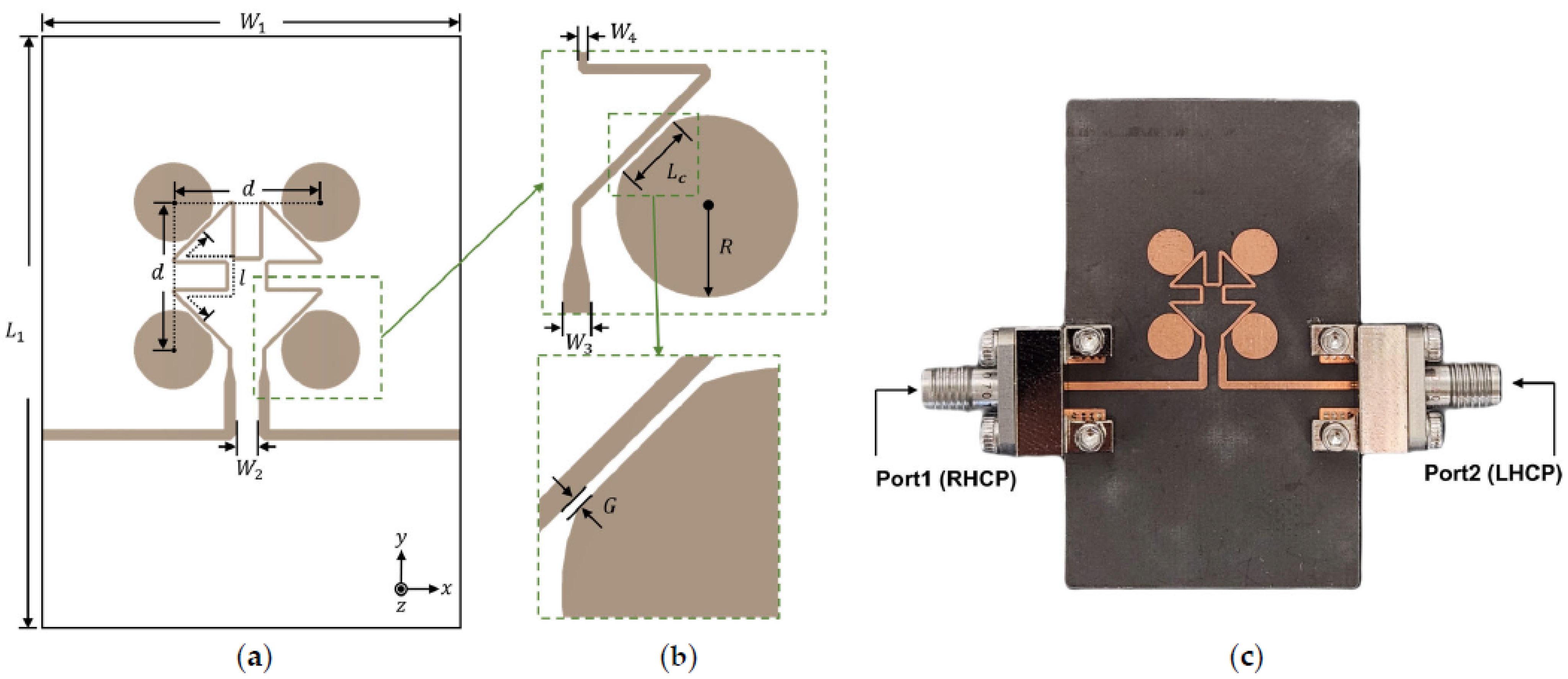
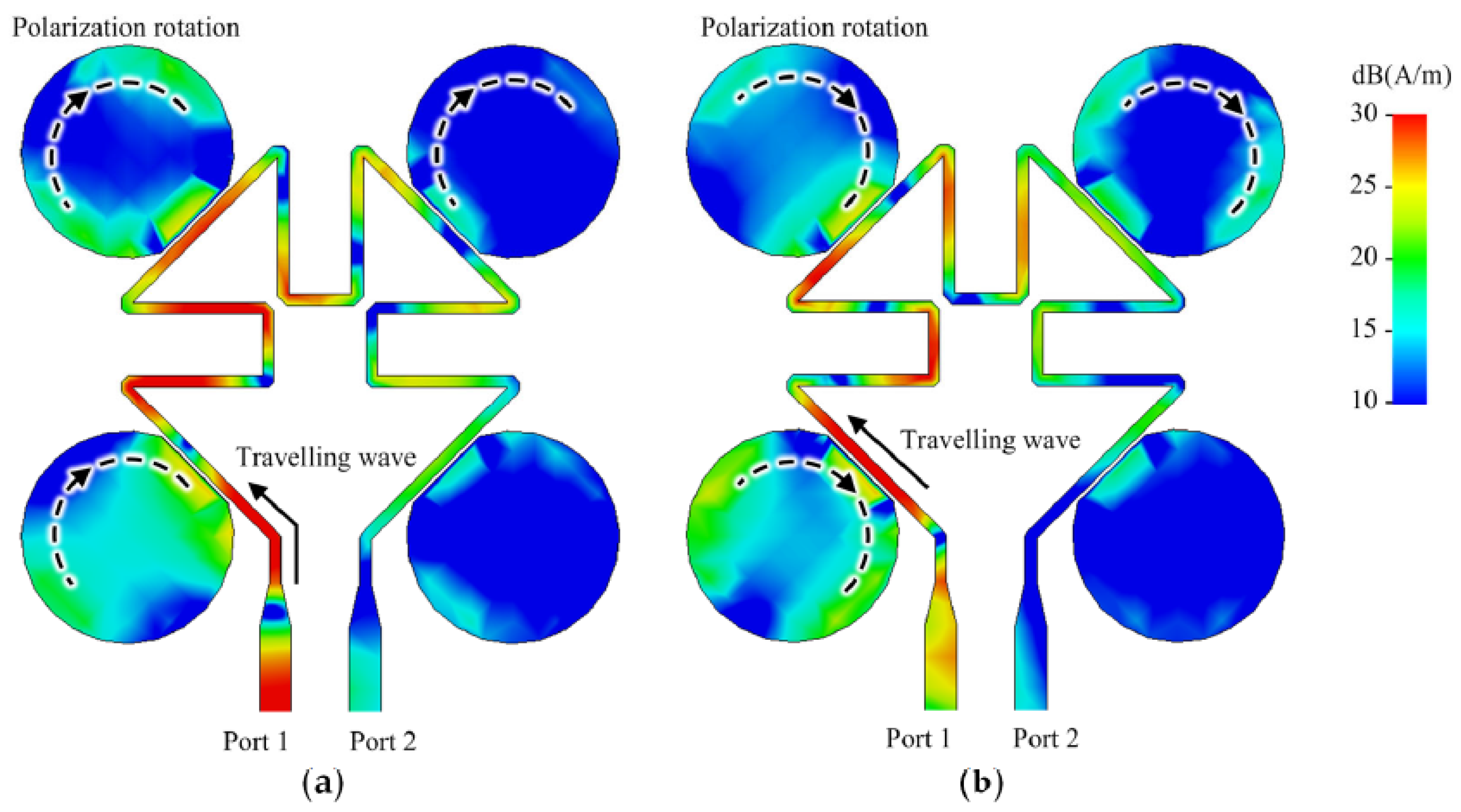

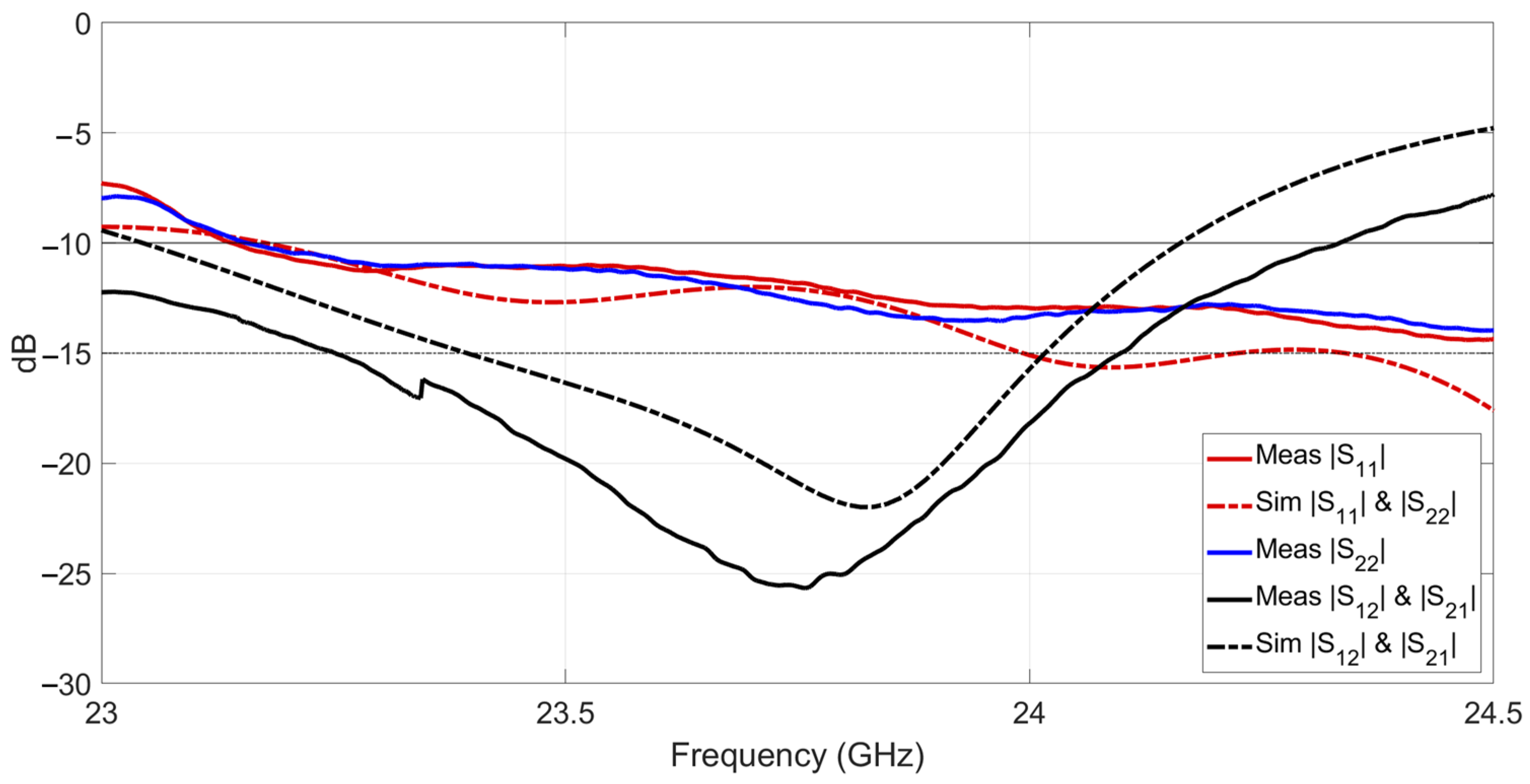
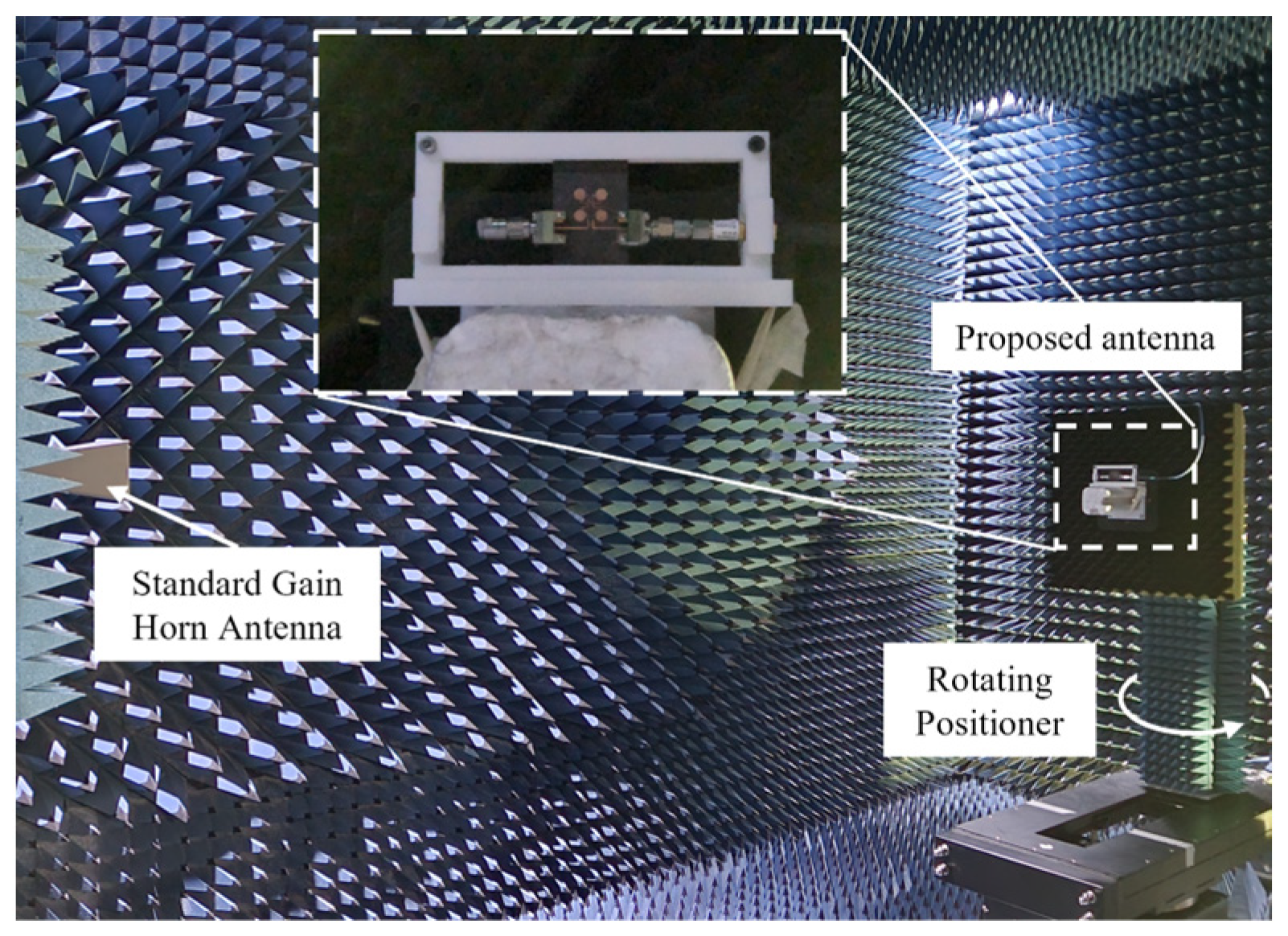
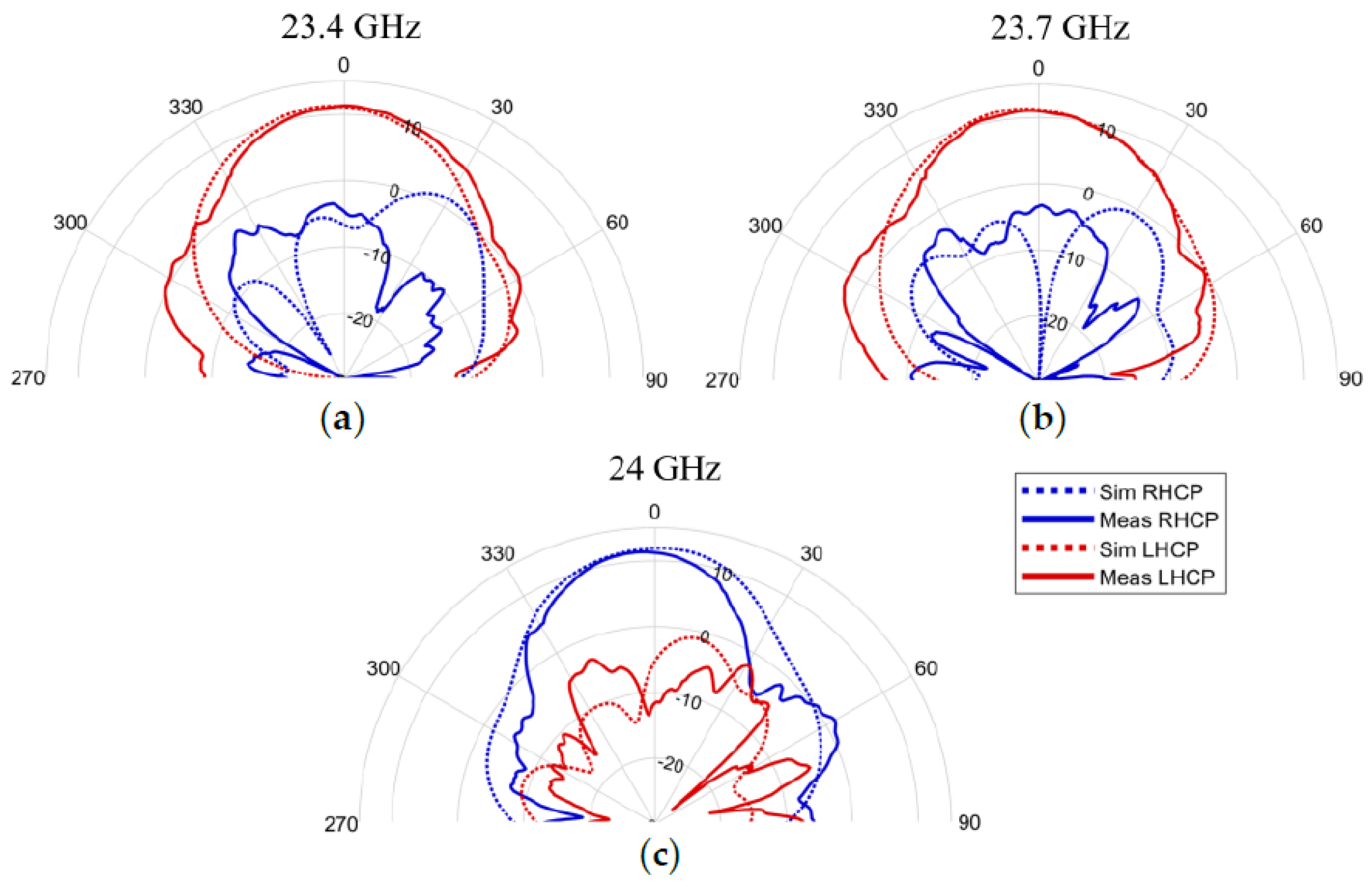
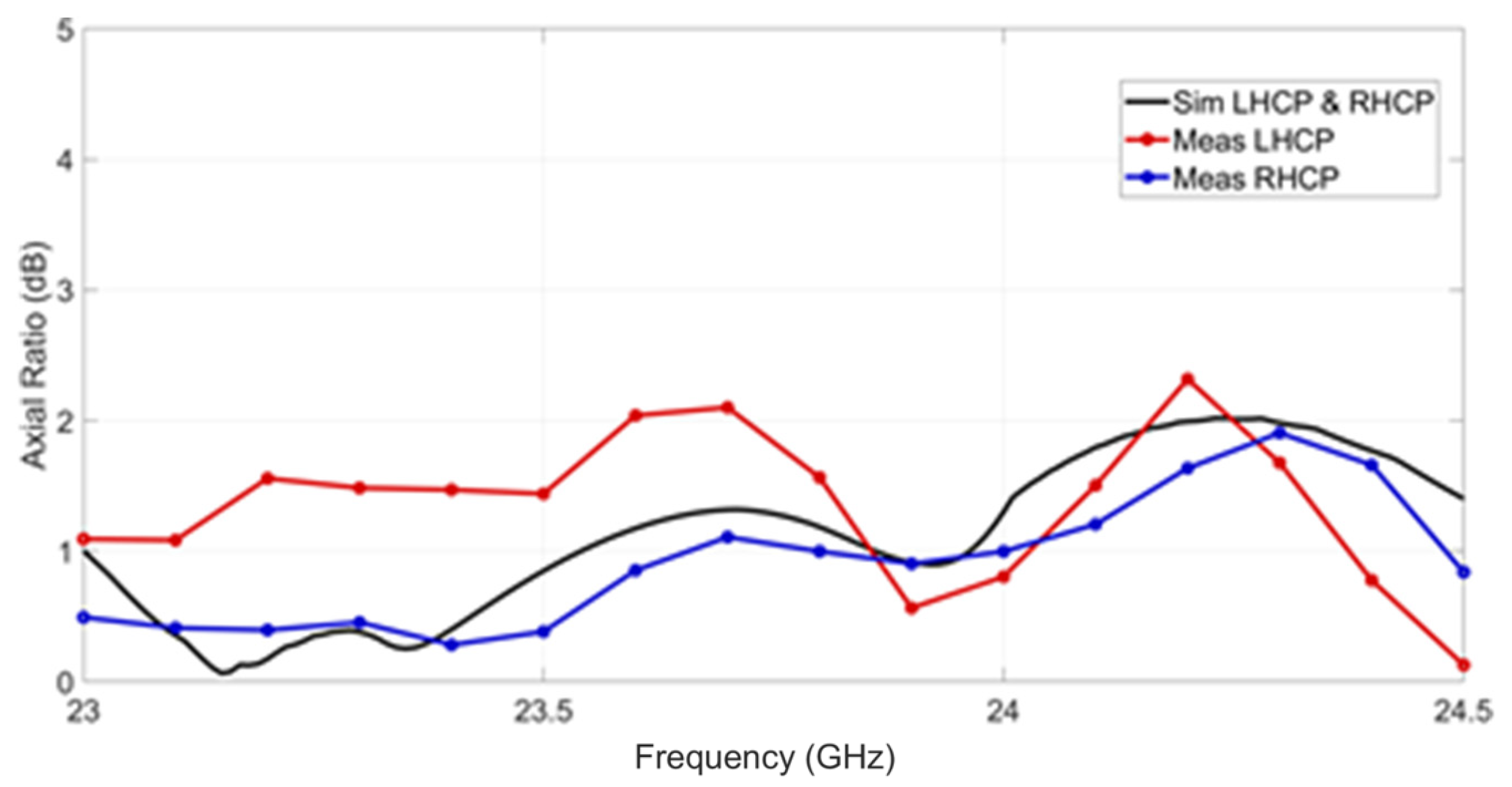

| Reference | Size (mm) | Peak Gain (dBi) | Axial Ratio Bandwidth (GHz) | Impedance Bandwidth (GHz) | Dual CP |
|---|---|---|---|---|---|
| [32] | 76.2 76.2 0.5 | 6 * | 18–18.55 19.8–20.25 | 18.35–20.18 | No |
| [33] | 29.5 9.35 | 6.56 * | 21.2–21.8 | 18.9–20.76 21.9–25.5 | No |
| [34] | 12 | 4.9 | 18.4–19.8 | 17.5–20.5 | Yes |
| [35] | 7.5 | 4 | 19.8–20.1 | 19.8–21.1 | No |
| This work | 30 | 11.5 | 23–25 | 23.16–24.92 | Yes |
| Parameter | Physical Meaning | Value |
|---|---|---|
| f1, f2 | frequency of two-tone signal | 23.4 GHz, 23.7 GHz |
| Pt | transmit power | 27 dBm |
| etotal | efficiency of proposed antenna | −0.86 dB |
| Gt | proposed antenna gain | 11.6 dBi |
| FSPL | free space path loss | -60 dB |
| d | distance | 1 m |
| Ptag | input power to the non-linear tag | −10.6 dBm |
| lIM3 | conversion loss of third-harmonics generator | −19 dB |
| Gtag | gain of proposed antenna in tag | 11.6 dBi |
| Pr | receive power | −68.9 dBm |
Disclaimer/Publisher’s Note: The statements, opinions and data contained in all publications are solely those of the individual author(s) and contributor(s) and not of MDPI and/or the editor(s). MDPI and/or the editor(s) disclaim responsibility for any injury to people or property resulting from any ideas, methods, instructions or products referred to in the content. |
© 2023 by the authors. Licensee MDPI, Basel, Switzerland. This article is an open access article distributed under the terms and conditions of the Creative Commons Attribution (CC BY) license (https://creativecommons.org/licenses/by/4.0/).
Share and Cite
Lee, W.; Oh, S.; Hong, S.K. Compact Dual-Circularly Polarized Traveling-Wave Series-Fed Patch Array for Use as a Non-Linear Tag Antenna for Bio-Sensing Applications. Appl. Sci. 2023, 13, 7729. https://doi.org/10.3390/app13137729
Lee W, Oh S, Hong SK. Compact Dual-Circularly Polarized Traveling-Wave Series-Fed Patch Array for Use as a Non-Linear Tag Antenna for Bio-Sensing Applications. Applied Sciences. 2023; 13(13):7729. https://doi.org/10.3390/app13137729
Chicago/Turabian StyleLee, Wonryeol, Sooyoung Oh, and Sun K. Hong. 2023. "Compact Dual-Circularly Polarized Traveling-Wave Series-Fed Patch Array for Use as a Non-Linear Tag Antenna for Bio-Sensing Applications" Applied Sciences 13, no. 13: 7729. https://doi.org/10.3390/app13137729
APA StyleLee, W., Oh, S., & Hong, S. K. (2023). Compact Dual-Circularly Polarized Traveling-Wave Series-Fed Patch Array for Use as a Non-Linear Tag Antenna for Bio-Sensing Applications. Applied Sciences, 13(13), 7729. https://doi.org/10.3390/app13137729






